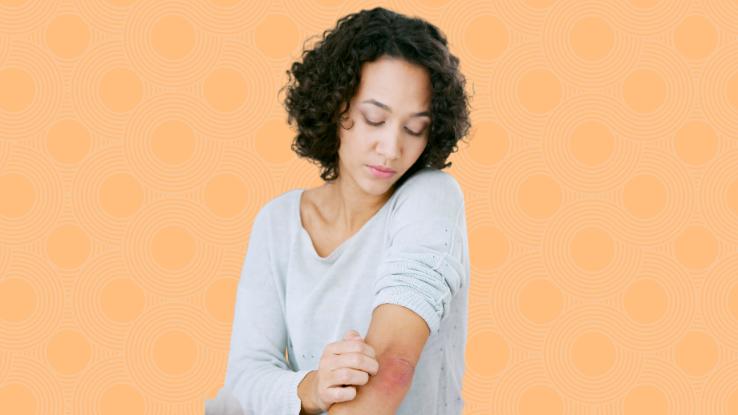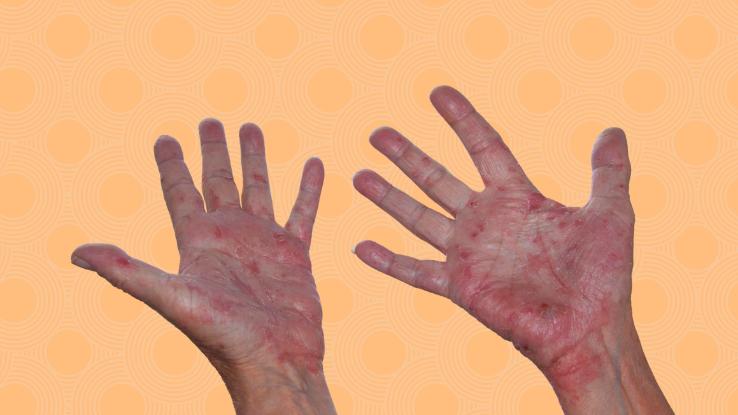Eczema 101: Everything You Need to Know About Dermatitis

Have you ever had a red, itchy rash that does not go away — or that flares up time and again? Chances are, it may be eczema, or, as it’s sometimes known, dermatitis. Although mild eczema is not life threatening, it can be extremely uncomfortable, and severe forms of it can greatly impact the quality of life for those affected.
Symptoms vary depending on the type of eczema and from person-to-person, but usually include eczema goes hand-in-hand with dry, scaly, red, and/or itchy skin. If left untreated, constant scratching may lead to bleeding, crusting, or broken skin, which leaves the patient more at risk to possible infection. So, what exactly is eczema — and what can you do to manage it?
What Is Eczema?
“Eczema” is a general term used to describe dermatitis (a skin irritation), and, most often, you will hear the two terms used interchangeably. Although it comes in many forms, eczema generally describes a dry skin condition that may be relieved by moisturizers and emollients. This skin condition is not contagious, so you cannot pass it on or catch it through contact with others.
According to the National Eczema Association, more than 31 million people in the U.S. have some form of eczema. One in 10 people will develop eczema at some time in their lives, and it most commonly appears during early childhood.
Children with the most common type of eczema, called atopic dermatitis, often develop related conditions in a typical sequence of food allergy, allergic rhinitis or “hay fever” (runny nose, sneezing, itchy or watering eyes), and asthma. Some of these conditions may continue into adulthood, whereas others may resolve during childhood.
Common Types of Eczema
Atopic dermatitis (AD)
- AD is the most common type of eczema that often affects infants and children. “Atopic” means that the symptoms affect a part of the body that does not come into contact with the allergen. Also known as atopic eczema or infantile eczema, AD can affect adults too. AD is characterized by irritated, red rashes that can result in small, fluid-filled bumps. Children who have a family history of hay fever, asthma, or allergies are more genetically predisposed to the condition because flare-ups of AD are usually triggered by these specific reactions. Fortunately, more than half of infants or toddlers who suffer from atopic dermatitis grow out of the condition by the time they are teenagers. People with atopic dermatitis are at increased risk of developing bacterial, viral and fungal skin infections.
Contact Dermatitis
- Contact dermatitis, also called contact eczema, is a condition that flares up when the skin is in direct contact with irritants or allergens in the environment. The triggers can include solvents, detergents, smoke, paint, bleach, fabrics, or ingredients found in skincare products. As the name suggests, direct contact is needed for an outbreak, so contact dermatitis is seen mostly on the hands or on parts of the body that touched the allergen trigger.
Pompholyx Eczema
- Also known as dyshidrotic eczema or dyshidrotic dermatitis, pompholyx is a blistering type of eczema and is limited to the fingers, palms, and soles of the feet. Symptoms include inflamed and very itchy patches of scaly skin that flake and may become cracked and painful. This condition is twice as common in women and is usually the result of stress, sensitivity to metal compounds (often nickel), heat, or sweating.
Discoid Eczema
- This skin condition, also known as nummular dermatitis, affects the lower legs and forearms in very dry, sometimes crusty, circular patches. Unlike most eczema, discoid types are usually non-irritating and do not result from allergies or asthma. It is thought that a bacterial infection can be a secondary cause to trigger the flare-up. This type is more commonly experienced by cis men.
Seborrhoeic Eczema
- Seborrhoeic eczema is characterized by a red, scaly, itchy rash in multiple places on the body that tend to have high oil secretion. The more commonly affected areas include the scalp, sides of nose, eyebrows, eyelids, behind the ears, and the middle of the chest. Scaly skin may appear in the form of dandruff on affected areas of the scalp. This form of dermatitis is usually caused by the yeast Malassezia furfur (formerly known as Pityrosporum ovale), which thrives in sebaceous (oily) environments. This form of eczema can also affect infants under the age of one year and can be easily treated.

Symptoms Associated With Eczema
The most common symptom of eczema is red, swollen, and painful itchy skin. The symptoms vary depending on the specific type of eczema. Blisters and scaly patches are also possible symptoms of eczema. These blisters can ooze, crust and even bleed. The color of the affected skin can change, and the skin can become thick and leathery. These outbreaks can appear almost anywhere on the body, and the location of the affected area often helps to classify the particular type of eczema and its causes.
Common Causes of Eczema
A specific cause for eczema has yet to be identified, though many genetic and environmental factors have been explored. Some research indicates that people with eczema may have a mutation in a gene that makes a protein called filaggrin. This protein is important in maintaining a healthy protective barrier on the top layer of the skin. Without enough filaggrin to build a strong skin barrier, moisture can escape and bacteria or viruses can enter. Other factors that cause or worsen eczema might include stress or autoimmune disorders.
Diagnosing Eczema
There is no specific diagnostic test for eczema. Your doctor will diagnose the condition by examining your skin and reviewing your medical history. A dermatologist may use patch testing to rule out other skin diseases or identify a specific condition associated with your eczema, such as a food allergy.
Treatment & Management of Eczema
No cure exists for eczema, but there are several effective treatments. In addition, home remedies can help relieve itch and irritation when a breakout occurs. Managing known triggers and implementing some lifestyle changes may help control flare-ups. In particular, you’ll want to manage three different factors: medications you take, your skincare regimen, and any of your potential or known triggers.
Medication
- Most itching and discomfort caused by mild cases of eczema can be relieved using an over-the-counter cortisone cream. These creams are easily accessible, cost effective, and can help prevent breakouts if applied frequently. For more serious cases of eczema, a dermatologist might prescribe a stronger topical corticosteroid. In severe cases, oral steroids may be prescribed to prevent constant flare-ups, although long-term use of oral steroids is not recommended because of serious side effects.
Home Remedies
- Skin care using moisturizers is an important part of maintaining a protective barrier. Choose moisturizers without heavy fragrances, as these may also irritate the skin. Soaking the hands in room temperature water for several minutes before applying moisturizing cream may help the skin cells to remain hydrated. Additionally, consider wearing cotton gloves at night to prevent scratching.

Dietary Changes
- Minor diet alterations can be used, after consultation with your healthcare provider, to help reduce episodes of eczema flare-up. For example, avoiding foods that are inflammatory in nature, such as alcohol or caffeine, may benefit those with constant eczema. Keeping a food diary might help you to identify the specific food(s) that trigger your eczema. Always try to eat a healthy, nutritionally balanced diet to strengthen your immune system and help prevent further eczema-triggering allergies.
Managing Triggers
- Avoid contact with known allergens and irritants (for example, certain types of laundry detergent) and look for organic, naturally derived products. Wear loose, comfortable clothing, and wash all new clothing before wearing it. Keep your fingernails cut short and smooth so that scratching does not break the skin and expose you to heightened risk of infection. Try applying a high-SPF sunscreen to prevent sun damage to sensitive skin. And, finally, use a HEPA filter to minimize airborne allergens in the home. Need more suggestions? The National Eczema Association has numerous fact sheets to help you manage eczema flare-ups and symptoms.
Next Steps for Managing Your Eczema
Although minor eczema flare-ups can be treated using over-the-counter medications, see your healthcare provider if you have a more severe episode — or more severe symptoms of infection and/or allergies. If you need help managing more severe or chronic eczema, you may be referred to a dermatologist.
Resource Links:
- “Eczema Stats” via National Eczema Association
- “What Is Eczema?” via National Eczema Association
- “Causes and Triggers of Eczema” via National Eczema Association
- “Atopic Dermatitis (Eczema) — Symptoms & Causes” via Mayo Clinic
- Patient Fact Sheets via National Eczema Association
- “Atopic Dermatitis (Eczema) — Diagnosis & Treatment” via Mayo Clinic
- “Filaggrin and childhood eczema” via Archives of Disease in Childhood, BMJ
- “Eczema (Atopic Dermatitis) Treatment” via National Institute of Allergy and Infectious Diseases
- “Can Anything Relieve Severe Atopic Dermatitis?” via American Academy of Dermatology Association (AAD)
- “Eczema (Atopic Dermatitis) Overview” via American Academy of Allergy Asthma & Immunology (AAAA&I)





